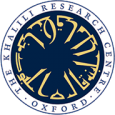About
The Khalili Research Centre (KRC) is the University of Oxford’s centre for research into the art and material culture of the Islamic societies of the Middle East and of their non-Muslim members and neighbours. It is also the University’s centre for teaching the subject, especially to graduate students, but also to undergraduates. The KRC is part of the Faculty of Asian and Middle Eastern Studies in the University.
The KRC was founded in 2004 thanks to a generous benefaction from the renowned scholar, collector and philanthropist, Professor Nasser David Khalili. His initial benefaction included the restoration and conversion of three early 19th-century terraced houses in St John Street, in the heart of Oxford, as the premises of the KRC, and the endowment of the running costs of the centre. The KRC was officially opened on 4 July 2005 by Lord Patten of Barnes, the Chancellor of the University. Professor Khalili made a subsequent gift in kind of the refurbishment of part of no. 2 St John Street and its incorporation into the KRC. He maintains a close interest in the work of the centre, and continues generously to support its activities.
Professor Khalili is a Member of the Chancellor’s Court of Benefactors, and his name is inscribed on the Clarendon Arch, near the entrance of the historic Bodleian Library, amongst those of major benefactors to the University through the centuries. The KRC logo also celebrates Professor Khalili’s generosity to Oxford: it is drawn from a slip-painted bowl in his collection, which was made in Nishapur (Iran) in the tenth-century and is inscribed in Arabic with the Islamic saying: al-jūd min akhlāq ahl al-janna, “Generosity is one of the virtues of those who dwell in paradise”.
The artistic traditions studied at the centre cover a chronological span of over a millennium. Its horizons stretch from the Mediterranean to Iraq, Iran – and often beyond, to societies from China in the East to Morocco in the West. The centre brings together one of the largest international concentrations of specialists in this field, who form an active community of leading scholars, postdoctoral researchers, DPhil students and Master’s students, usually taught in small groups.
The KRC is located on St John Street, in central Oxford. It comprises offices for staff and researchers, a state-of-the-art top-floor room with dedicated student spaces, a lecture and seminar room, image digitisation room, and a common room. Self-contained accommodation is also available for visiting scholars.
The KRC adjoins the Art, Archaeology and Ancient World Library with its extensive holdings of books and journals on Middle Eastern art and visual culture, the Faculty of Asian and Middle Eastern Studies Library, with its extensive Arabic, Persian and Turkish collections, and the Ashmolean Museum, with its superb collection of Islamic art. It is a few minutes’ walk from the Bodleian Library, one of the largest research libraries in the world with major collections of Arabic, Persian and Turkish manuscripts, and a national copyright deposit library.
Teaching of Islamic Art at Oxford prior to the Khalili Research Centre
Interest in Islamic art and archaeogy as a degree subject at Oxford increased following the appointment of Robert Hamilton, the excavator of Khirbat al-Mafjar, first as Senior Lecturer in Near Eastern Archaeology at the university in 1949, then as Keeper of the Department of Antiquities at the Ashmolean Museum from 1956, and as Keeper of the Ashmolean Museum between 1962 and 1972. During this extended period, Professor Hamilton supervised students to DPhil level, supplemented by courses on Islamic pottery with Sophie Walzer and Geza Fehervari held in the Ashmolean’s Eastern Art Library, and on numismatics by Helen Mitchell-Brown in the Heberden Coin Room.
Following the completion of his doctorate in October 1976, James Allan, as Assistant Keeper of the Islamic Collections in the Ashmolean’s Department of Eastern Art, designed a two-year MPhil degree course in Islamic Art and Architecture. In 1979 he was joined by his first DPhil student, Julian Raby, as Departmental Lecturer in Islamic Art and Architecture at the Oriental Institute (now the Faculty of Asian and Middle Eastern Studies), funded by the World of Islam Festival Trust. This junior lectureship was subsequently upgraded to the full University Lectureship, endowed by a group of Middle Eastern businessmen, which continues to this day.
The original MPhil in Islamic Art and Architecture was a degree in Oriental Studies at the Oriental Institute (now the Faculty of Asian and Middle Eastern Studies), but with lectures located in the Ashmolean Museum to maximise the use of storage collections in the teaching process. Initially, the course was based on media papers combined with one paper on the history and art of a particular period. This was later changed to teaching and examination by period, and expanded to include a larger component of archaeology when Jeremy Johns joined the team in 1990. In the early days, the teaching took place in the Eastern Art Department’s Library, adjacent to the storage housing study collections. With the building of the new Reitlinger Gallery in 1981 the teaching was moved to the Reitlinger Seminar Room, directly above the Islamic Gallery and with direct access to storage. Julian Raby’s room was in the attic of No 3 St John Street, now part of the students’ room at the KRC.
Please note that the Khalili Collections are not part of the Khalili Research Centre



